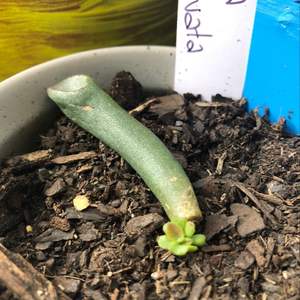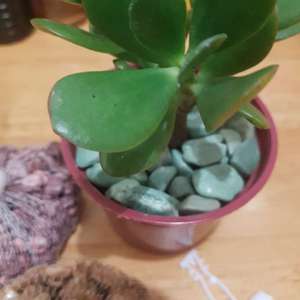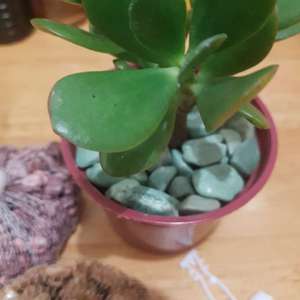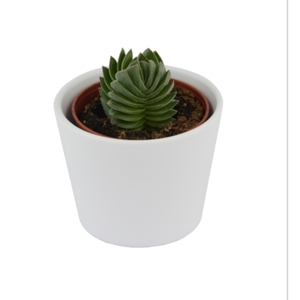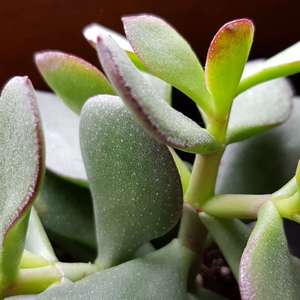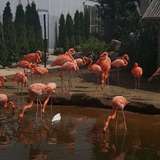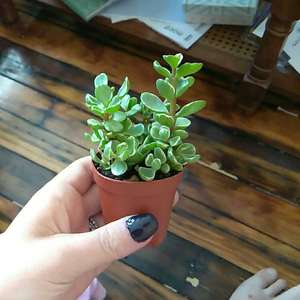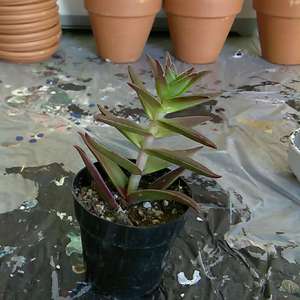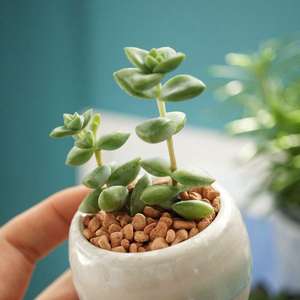成长记
Maritza Sanchez
2018年06月29日

I Nuevo agregado un Crassula Ovata, miniatura/ árbol de dinero en mi jardín


0
0
成长记
Maritza Sanchez
2018年06月29日

I Nuevo agregado un Crassula Ovata/ árbol de dinero o de la abundancia en mi jardín


0
0
成长记
Maritza Sanchez
2018年06月26日

I Nuevo agregado un Crassula ovata/ dedos de Gollum en mi jardín
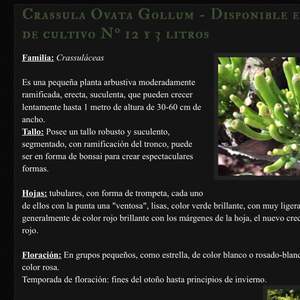

0
0
文章
Miss Chen
2018年06月26日

1.Crassula Plants
:Succulent plants offer low maintenance and diverse shapes and textures, both in the garden and indoors. Crassula is a diverse and extensive genus of succulent plants, with about 350 species. Probably the most well-known is Jade plant (Crassula ovata). Many of us know it as a houseplant, but in warm climates, it grows into a shrub.
Many other Crassula species are much smaller, including some miniatures and creeping ground covers. They are all quite fascinating, the types of plants you see occasionally and wonder "What is that?" With the resurgence of succulent container gardening, these smaller Crassula species are becoming more readily available and their easy growing habit makes them worth getting to know.
Botanical Name
Crassula spp.
Common Names
Because of the shapes and forms of their leaves, Crassula plants lend themselves to very descriptive common names. Crassula barklyi, the 'Rattlesnake Plant', looks like the tip of the snake's tail. Crassula argentea, shown here, is called ‘Living Coral’. Crassula perforata, with it's twirling leaves stacked one on top of another is known as 'String of Buttons'. This is an intriguing genus of plants.
Hardiness Zones
Most Crassula species are only reliably hardy in USDA Zones 9 - 10, but elsewhere you could bring them indoors for the winter. They won't get as large as plants grown outdoors, but they make great houseplants.
Sun Exposure
Full sun to partial shade. Most Crassula plants need some shade in the hottest part of summer, but require bright light to attain their most vibrant color. A site with morning sun and afternoon shade would be perfect.
Mature Plant Size
Size will vary with species and variety, from shrubs several feet tall to tiny specimens of a couple of inches.
Bloom Period
Spring and summer. Some varieties of Crassula have lovely flowers and others are insignificant. Many gardeners remove the flowers that are not particularly showy.
Design Tips for Crassula
The smaller Crassula are perfect container plants - low maintenance, evergreen and eye-catching. If you have the climate, the plants look terrific tucked into and hanging over walls.
Jade plants in their natural element will be one of the easiest to maintain plants in your garden. Their dark, glossy green color is a great foil for almost any flower color.
Suggested Crassula Varieties to Grow
There are so many to choose from, you may become a collector. Here are a few that might catch your eye.
Crassula "Morgan’s Beauty": Thick silver leaves dusted in white, with pretty pink late spring flowers. Grows about 8 inches wide.
Crassula erosula "Campfire'": Long branching leaves turn blazing red in winter. A clump former that grows about 1 ft. tall and spreads 3 ft. wide.
Crassula pellucida subsp. marginalis "Variegata": a flowing mass of heart-shaped leaves variegated in pink, green and creamy yellow. Nice in a hanging pot.
Crassula perforata: Known as the stacked Crassula, their leaves rotate around a central stem, giving them their common name, String of Buttons'.
2.Growing and Caring for Crassula
Crassula Growing Tips
Soil: Crassula plants need very well draining soil, but they are not particular about soil pH. Sandy or even rocky soil is fine.
Water: As succulents, they don't need frequent watering, since they store it in their leaves. If they are left to sit in wet soil, their roots will rot. During cooler months, give them a good drenching and then allow the soil to dry out, before watering again. They go dormant when the temperature gets hot in summer and need even less water.
Feeding: Feed sparingly. You can give your plants a little organic fertilizer in mid-spring, as they start actively growing.
Propagation: Crassula plants are generally started by division, offsets or leaf cuttings.
Caring for Your Crassula Plants
Crassula can be sensitive to temperature. Too hot and they will go dormant and drop their lower leaves. Too cold and they will simply pout, not doing much of anything. Other than that, they laugh off both neglect and abuse.
Stacking Crassulas send out suckers, which is really only a problem when grown in the ground. However they are slow growers and can be controlled with a little effort.
When plants start to get straggly or leggy, don't be afraid to cut them back.
Pests and Problems
Keep an eye out for the usual succulent pests: aphids, mealy bugs and spider mites. The biggest problem is root rot and sparse watering will help avoid that.
:Succulent plants offer low maintenance and diverse shapes and textures, both in the garden and indoors. Crassula is a diverse and extensive genus of succulent plants, with about 350 species. Probably the most well-known is Jade plant (Crassula ovata). Many of us know it as a houseplant, but in warm climates, it grows into a shrub.
Many other Crassula species are much smaller, including some miniatures and creeping ground covers. They are all quite fascinating, the types of plants you see occasionally and wonder "What is that?" With the resurgence of succulent container gardening, these smaller Crassula species are becoming more readily available and their easy growing habit makes them worth getting to know.
Botanical Name
Crassula spp.
Common Names
Because of the shapes and forms of their leaves, Crassula plants lend themselves to very descriptive common names. Crassula barklyi, the 'Rattlesnake Plant', looks like the tip of the snake's tail. Crassula argentea, shown here, is called ‘Living Coral’. Crassula perforata, with it's twirling leaves stacked one on top of another is known as 'String of Buttons'. This is an intriguing genus of plants.
Hardiness Zones
Most Crassula species are only reliably hardy in USDA Zones 9 - 10, but elsewhere you could bring them indoors for the winter. They won't get as large as plants grown outdoors, but they make great houseplants.
Sun Exposure
Full sun to partial shade. Most Crassula plants need some shade in the hottest part of summer, but require bright light to attain their most vibrant color. A site with morning sun and afternoon shade would be perfect.
Mature Plant Size
Size will vary with species and variety, from shrubs several feet tall to tiny specimens of a couple of inches.
Bloom Period
Spring and summer. Some varieties of Crassula have lovely flowers and others are insignificant. Many gardeners remove the flowers that are not particularly showy.
Design Tips for Crassula
The smaller Crassula are perfect container plants - low maintenance, evergreen and eye-catching. If you have the climate, the plants look terrific tucked into and hanging over walls.
Jade plants in their natural element will be one of the easiest to maintain plants in your garden. Their dark, glossy green color is a great foil for almost any flower color.
Suggested Crassula Varieties to Grow
There are so many to choose from, you may become a collector. Here are a few that might catch your eye.
Crassula "Morgan’s Beauty": Thick silver leaves dusted in white, with pretty pink late spring flowers. Grows about 8 inches wide.
Crassula erosula "Campfire'": Long branching leaves turn blazing red in winter. A clump former that grows about 1 ft. tall and spreads 3 ft. wide.
Crassula pellucida subsp. marginalis "Variegata": a flowing mass of heart-shaped leaves variegated in pink, green and creamy yellow. Nice in a hanging pot.
Crassula perforata: Known as the stacked Crassula, their leaves rotate around a central stem, giving them their common name, String of Buttons'.
2.Growing and Caring for Crassula
Crassula Growing Tips
Soil: Crassula plants need very well draining soil, but they are not particular about soil pH. Sandy or even rocky soil is fine.
Water: As succulents, they don't need frequent watering, since they store it in their leaves. If they are left to sit in wet soil, their roots will rot. During cooler months, give them a good drenching and then allow the soil to dry out, before watering again. They go dormant when the temperature gets hot in summer and need even less water.
Feeding: Feed sparingly. You can give your plants a little organic fertilizer in mid-spring, as they start actively growing.
Propagation: Crassula plants are generally started by division, offsets or leaf cuttings.
Caring for Your Crassula Plants
Crassula can be sensitive to temperature. Too hot and they will go dormant and drop their lower leaves. Too cold and they will simply pout, not doing much of anything. Other than that, they laugh off both neglect and abuse.
Stacking Crassulas send out suckers, which is really only a problem when grown in the ground. However they are slow growers and can be controlled with a little effort.
When plants start to get straggly or leggy, don't be afraid to cut them back.
Pests and Problems
Keep an eye out for the usual succulent pests: aphids, mealy bugs and spider mites. The biggest problem is root rot and sparse watering will help avoid that.
0
1



